Fire Safety Information
Fire Safety information is an essential life-saving knowledge to save lives and properties.
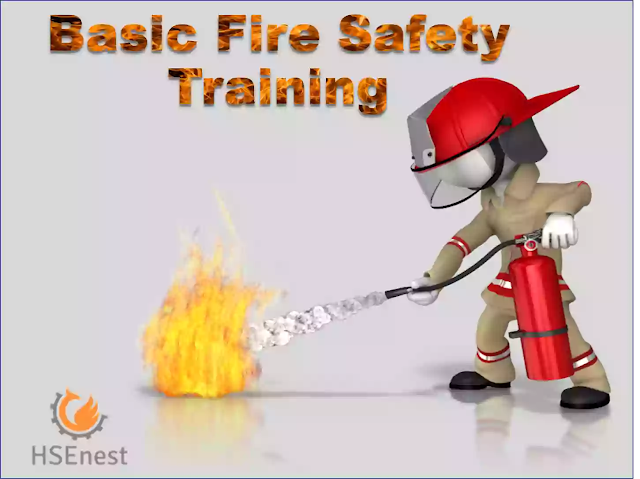 |
| Basic Fire Safety Information |
Also, many lives and properties can be preserved, if you have basic fire safety knowledge and fire fighting equipments.
To download the Basic Fire Safety Training video and Pocket guide scroll down.
What is Fire?
Fire is the rapid oxidation chemical reaction between three elements, Oxygen, Heat, Fuel and typically releasing heat, light, and various reaction products.
The Elements of Fire
There are three essential elements that are necessary to ignite the fire.
- First, Fuel, such as wood, paper, oil, etc.
- Second, Heat, such as open flame, sparks, friction, etc.
- Third, Oxygen, source from air or oxygen gas cylinder.
Whenever these three elements come together in a proper ratio, then Fire will take place.
This is known as "Fire Triangle"
 |
| Fire Triangle |
To continue fire, the fourth element is required that is called "Chemical chain reaction".
And, This is known as "Fire tetrahedron".
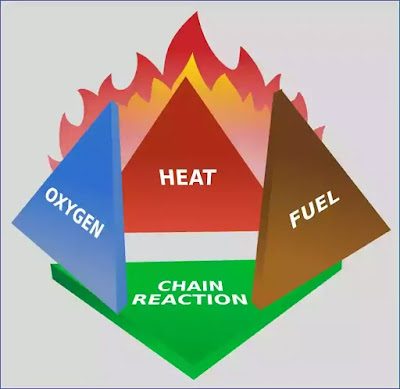 |
| Fire Tetrahedron |
Fire Extinguishing Methods
To extinguish the fire, remove any of element from the fire triangle.
There are four extinguishing methods to be used to douse the fire.
- First. Cooling, In this method removal of the heat from the fire triangle, for example, throws a glass of water on an ignited candle.
- Second, Smoothering or blanketing, In this method removal of the oxygen from the fire triangle, for example, put an empty glass on an ignited candle.
- Third, Starvation, In this method removal of fuel from the fire triangle, for example, leaves ignited candle and it will extinguish due to lack of wax.
- Fourth, Chain breaking, In this method breaks the chemical reaction from fire tetrahedron.
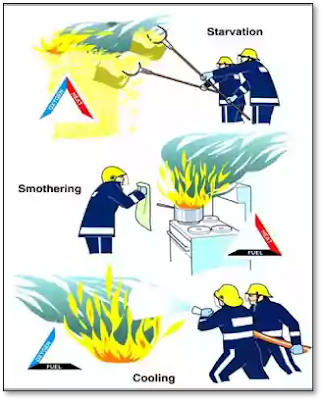 |
| Fire Extinguishing Methods |
Basic Fire Safety Video
Classification of Fire
According to Indian Standard IS 2190, fire has been divided into four types.
- Class A fire - This includes simple combustible materials such as paper, wood, cloth and some rubber and plastic materials.
- Class B fire - This includes combustible or flammable liquids (such as gasoline, petroleum grease, wire, oil, oil-based paints, solvents, alcohol).
- Class C fire- flames include flammable gases under pressure, including liquefied gases, where it is necessary to stop the burning gas at a rapid rate with an inert gas, powder or evaporating liquid to extinguish.
- Class D fires - Fires involving combustible metals such as magnesium, titanium, zirconium, sodium, lithium, and potassium.
Electric fire has not been added to the Indian Standard.
To extinguish an electric fire, first the flow of electricity has to be disconnected and which type of fire shown above is to be decided.
 |
| Symbols of different class of fire |
Fire Extinguisher Anatomy
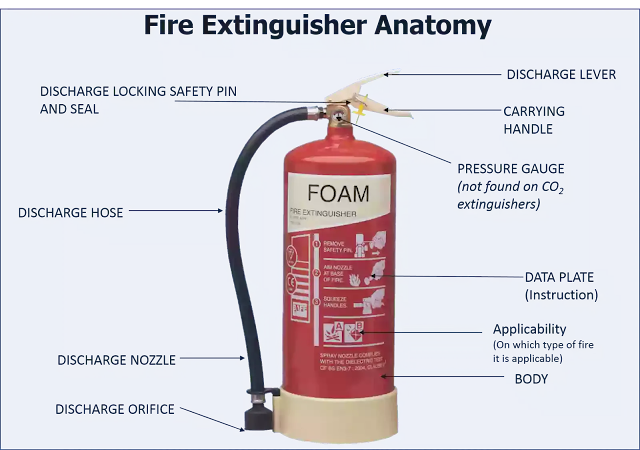 |
| Fire Extinguisher Anatomy |
Types of Fire Extinguishers
The 4 most common fire extinguishers are categorized by extinguishing media.
- Water Type Fire Extinguisher.
- Foam Type Fire Extinguisher.
- Co2 Type Fire Extinguisher.
- Dry Chemical Powder Type Fire Extinguisher.
Fire Extinguisher Selection Chart
 |
| Fire Extinguisher Selection Chart |
Fire Extinguisher Use
To operate fire extinguishers use the PASS method.
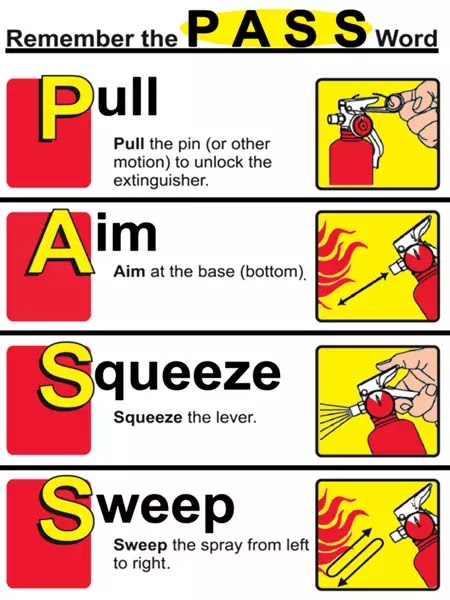 |
| PASS method |
Key Points for use of Fire Extinguisher
- Know how to operate.
- Know what is burning.
- Always keep an exit at your backside and ensure it is clear.
- Always operate from an upwind direction, in case of outdoor fire fighting.
- Never attempt to fight a fire Unless it is Safe to do so.
- Remember it can be dangerous to use the wrong extinguisher.
- Do Not Use if you are not trained.
- NEVER fight a fire if any of the following apply:
- Don’t have the proper extinguisher or equipment. ire has spread beyond its point of origin.
- Inconveniences for breathing.
- Improper visibility.
- Your instincts tell you to get out.
Fire Emergency Evacuation plan
- Evaluate the situation.
- Draw the attention of nearby people by alarm, siren, using a whistle or loudly shout out "FIRE" "FIRE" "FIRE".
- Immediately inform the "Fire Brigade" or "Police Station".
- If the fire is small attempt to extinguish the fire with the help of portable fire extinguishers.
- In the case of an electrical fire, the mains should be switched off.
- Contain the fire by sliding the doors and windows.
- Take the nearest exit and evacuate the area or building.
- Reach at the assembly point/safest place or 200 meters away from the danger zone.
- Cover your face and nose by wet cloth to reduce the intake of harmful smoke.
- If you stuck in building or area, do not take any decision in a panic condition such as jump from a building, etc. find out a safe shelter and wait for help.
- Do not use the lift to evacuate the building.
Fire Safety Broucher
Get the fire safety broucher as a pocket guide with embed essential "Fire Safety Information".
This flyer can be utilized for training material as well.
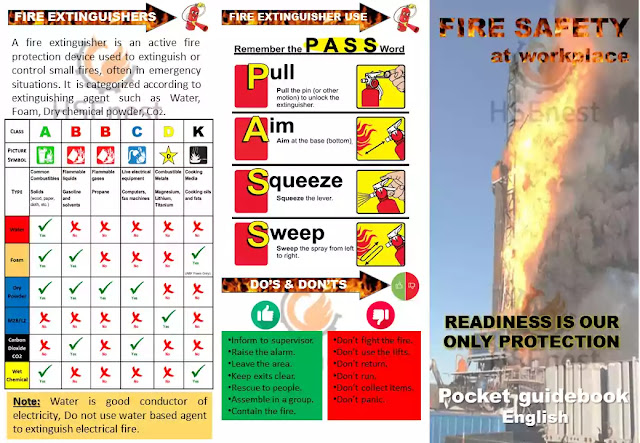 |
| Fire Safety Flyer Front |
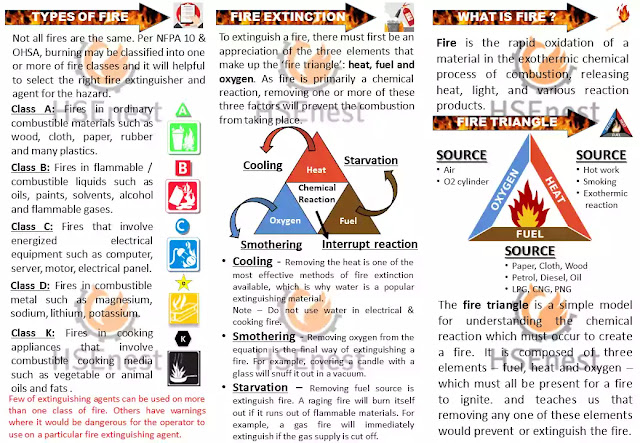 |
| Fire Safety Flyer Back |
To download "Basic Fire Safety" Video and Pocket guide, click on the below link after an email subscription.
For Video click here:
For Flyer Click here:
For Video click here:
For Flyer Click here:

Good attempt,covered all basic information.... Try to add more information, expecting more content.
ReplyDeleteRoby Justus
Health,Fire and Life Manager.
Thank you sir for your valuable inputs, it means lot for us.
DeleteWe are going to publish advance fire safety information soon.
Please share our blogs with other HSE practitioners to motivate us.
Thank You,
HSEnest Team.
All information is very useful
ReplyDeleteThanks for sharing with us.
Regards,
Smart safety Academy
https://safetyofficer2020.blogspot.com/
fire and safety BC Canada Wow, cool post. I'd like to write like this too - taking time and real hard work to make a great article... but I put things off too much and never seem to get started. Thanks though.
ReplyDelete